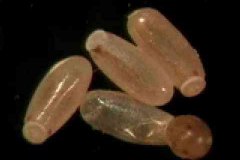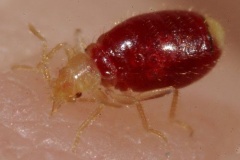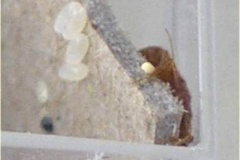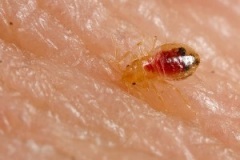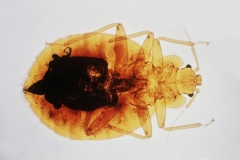Dr. Austin Frishmans first job in the industry was as a service technician for Clover Exterminators. Here he displays his work shirt from those early days.
Mark Goodman, regional operations manager, Plunketts Pest Control, shared a number of interesting case histories in a session titled, Troubleshooting Tricky Pest Problems.
Educational sessions were packed throughout the three-day event.
Educational sessions were packed throughout the three-day event.
A PMP signs a card congratulating Dr. Michael Potter on his retirement from the University of Kentucky.
KPMA Executive Director Melinda Howells invited PMPs to sign a card congratulating Dr. Michael Potter on his impending retirement from the University of Kentucky.
Consultant Stoy Hedges hosted the Cockroach House of Learning, a multi-hour educational session devoted to one of the industrys most important pests.
Ted Bruesch, technical support manager, Liphatech, shared Rodent Control Lessons of a Lifetime in his well-attended educational session.
Tom Myers, owner of All-Rite Pest Control, discussed Defensive Termite Inspection and Documentation on the first day of the 49th Annual University of Kentucky Pest Control Short Course.
Zach DeVries, assistant professor of urban entomology, told attendees hes looking forward to his new role at the University of Kentucky.
KPMA honored Gary Blankenship, owner of Guarantee Pest Control, Lexington, Ky., with its Lifetime Achievement Award.
The University of Kentucky Pest Control Short Course acknowledged its corporate sponsors with signage in the exhibit hall.
KPMA President Keith Smith thanked Dr. Michael Potter for his years of selfless service to the industry.
Rick Cooper, senior director of technical services, Terminix International, led an educational session devoted to Pest Identification for the Non-Entomologist.
Dr. Michael Potter and wife Ellen.
LEXINGTON, Ky. Standing on the Shoulders of Giants the theme of this years University of Kentucky Pest Control Short Course couldnt have been more fitting. Thats because the man responsible for leading one of the finest regional pest control conferences in North America, Dr. Michael Potter, is an industry giant himself.
After 29 years managing the short course, however, Potter recently announced his retirement. While a firm retirement date has yet to be determined, it will occur sometime next year, allowing Potter and his wife, Ellen, to relocate to Eugene, Ore., to be closer to their adult children.
Ill retain emeritus professor status in our department (a non-salaried position), but will not maintain a physical presence in Lexington, nor day-to-day departmental responsibilities, he wrote in an e-mail following the conference.
We didnt take this decision lightly, Potter said. In fact, he has been working on a succession plan with the university for two years, culminating in the choice of Dr. Zach DeVries, a protege of Dr. Coby Schal at North Carolina State University, to take over Potters role leading the conference. In February, DeVries accepted a tenure-track position as assistant professor of urban entomology at the university.
During the opening ceremonies of this years conference, Kentucky Pest Management Association (KPMA) President Keith Smith thanked Potter for his generous contributions to the industry, presenting the avid fly fisherman with a trip to Hubbards Yellowstone Lodge in Emigrant, Mont., as a token of appreciation for his body of work in support of the association. The five-day trip includes a guided tour of Yellowstone National Park and the Snake River.
Potter said joining the University of Kentucky was the best decision of my life and KPMA members have become his extended family. Whatever good we did, we did it together, he said. While Potter said hell miss overseeing the conference, the university is in really, really good hands thanks to the appointment of DeVries.
We feel we have (recruited) the top young urban entomologist in the U.S., bar none, Potter said. Zach works on all the important critters, so hes going to be a huge help to this state.
For his part, DeVries said hes excited about the prospect of building on Potters legacy and continuing to move the pest management industry forward. I really hope to follow in the footsteps (of Mike Potter) the best I can.
In other news, KPMA honored Gary Blankenship, owner of Guarantee Pest Control, Lexington, Ky., with its Lifetime Achievement Award. In recognizing the second-generation PMP, KPMA Director Chris Christensen said, When I think of Gary Blankenship, I think of selfless service to family and industry. Gary has always been a leader in our industry.
Since 1996, Blankenship has served as chairman of the associations pest control educational fund. In closing, Christensen said, Gary and his wife Lucy run a great business and are benevolent benefactors of a great group of employees.
In kicking off the educational portion of the program, Potter said the topics and speakers for this years short course were the strongest in his 29-year association with the conference. Its possible to see further by standing on the shoulders of giants, he observed, and this years speakers truly are giants in the pest control industry.
The leadoff speakers for the three-day event were industry consultant Stoy Hedges, who hosted a Cockroach Control House of Learning, and industry veteran Ted Bruesch of Liphatech, who shared Lessons of a Lifetime in rodent control.
I started out in this business as a pest control technician (for Wil-Kil Pest Control), Bruesch told attendees, so he understands the challenges faced by service personnel on a daily basis.
Bruesch said rodents are formidable foes, but theyre not as smart as many PMPs think. I hear all the time Ive got a smart rat, but I dont consider rodents as being particularly smart, he said. Their brain is the size of a lima bean and our brain weighs three pounds, so humans have a distinct intellectual advantage. Rodents simply have evolved over time, adopting unique behavioral characteristics that have allowed them to survive. Three behaviors, in particular, have served them well, according to Bruesch, allowing them to survive. They include:
1. Neophobia: Rodents are naturally skittish animals. When PMPs introduce something new to their environment, like a bait station, they are likely to shy away from it, Bruesch observes. What can you do to get around this behavior? Pre-bait, kill and repeat, he said. I want them to think of a bait station as a food source, not a bait station.
2. Social Hierarchy: In a (rodent) colony youre going to have a dominant male and a bunch of dominant females, he said. These alpha rodents, due to their superior physical characteristics, have access to the most food and the best housing. Subordinates (betas) are second in the pecking order and omegas are third. The goal is to take out the alphas by baiting aggressively, Bruesch said, then eliminating subsequent rodents who fill that void, eventually collapsing the colony.
3. Foraging Territories: By understanding the foraging territories of rats and mice, PMPs will place bait stations in the proper location. When youre dealing with mice, you need to have bait stations placed close (together), he said. When it comes to rats you really want those stations full (of bait).
Regardless of the challenges, I truly believe every rodent problem has a solution. You have to take the fight to the critter, Bruesch urged. You have to be aggressive.
In one of the more informative sessions of the three-day event, Mark Goodman, regional operations manager, Plunketts Pest Control, shared a number of interesting case studies in a session titled, Troubleshooting Tricky Pest Problems. Goodman recalled one situation where a technician was unable to control a maggot problem in a large egg production facility.
They called because they had maggots crawling in their production area, a high-stress situation, he said. Upon visiting the account, Goodman asked the usual questions, but nothing popped out as being particularly unusual until he got down on his hands and knees and began to check the silicone seals along a sterile hallway. Finally, we found one plate on a wall where there was some loose silicone, leading to a gap that went outside (the facility). Maggots were making their way up a drainpipe from some chicken dung outside and through the seal. Lesson learned? Sometimes you need to broaden your scope a little bit, Goodman said.
Other speakers on the star-studded program included Dr. Austin Frishman, owner, AMF Pest Management Consulting; Tom Myers, owner, All-Rite Pest Control; Rick Cooper, senior director of technical services, Terminix International; Marty Morgan, business development manager, Douglas Products; Mike Holcomb, consulting entomologist, Technical Directions; Pete Markham, president, A-Mark Pest & Bird Management; Ray Johnson, founder, Johnson Pest Control; Dr. Michael Potter, extension professor, University of Kentucky; Stephen Gates, vice president of technical services, Cooks Pest Control; Dan Collins, regional technical director, McCloud Services; Dr. Zach DeVries, assistant professor of urban entomology, University of Kentucky; and Gary Sigrist, CEO and president, Safeguard Risk Solutions.
Major sponsors of this years event included BASF Corporation and Oldham Chemicals. Additional sponsors included AP&G, Nisus, Bell Laboratories, Syngenta, Bayer, and Corteva Agriscience.
Next years University of Kentucky 50thAnnual Pest Control Short Course is scheduled for Nov. 10-12. Visit http://www.kyshortcourse.org for future updates and registration information.
The author is publisher of PCT magazine.
See the original post: Bed Bugs: We've Learned a Thing or Two - PCT Magazine
Visit link:
Texas, United States Bed Bug Registry Map World, Bed Bug ...

 Residence
Residence  Location
Location 

